Management Accounting & Financial Planning: Pricing, Budgeting & Tax
VerifiedAdded on 2023/06/17
|12
|3932
|179
Report
AI Summary
This report provides a comprehensive analysis of management accounting and financial planning, covering various aspects crucial for informed decision-making in business. It begins with a critical discussion of utilizing relevant costs for short-term pricing decisions, highlighting its limitations for long-term strategies and potential conflicts with traditional absorption costing. The report then evaluates the usefulness and limitations of capital investment techniques, such as Accounting Rate of Return (ARR), Payback Period, Net Present Value (NPV), Profitability Index (PI), and Internal Rate of Return (IRR), in choosing between alternative investment opportunities. Furthermore, it explores the role of budgeting in supporting enterprises beyond the Covid-19 pandemic, emphasizing its importance in financial planning and control. Finally, the report delves into the various means taxing authorities use to determine the reasonableness of transfer prices, ensuring compliance and minimizing tax liabilities. The report concludes by reinforcing the significance of management accounting and financial planning in achieving organizational goals and maintaining financial stability.
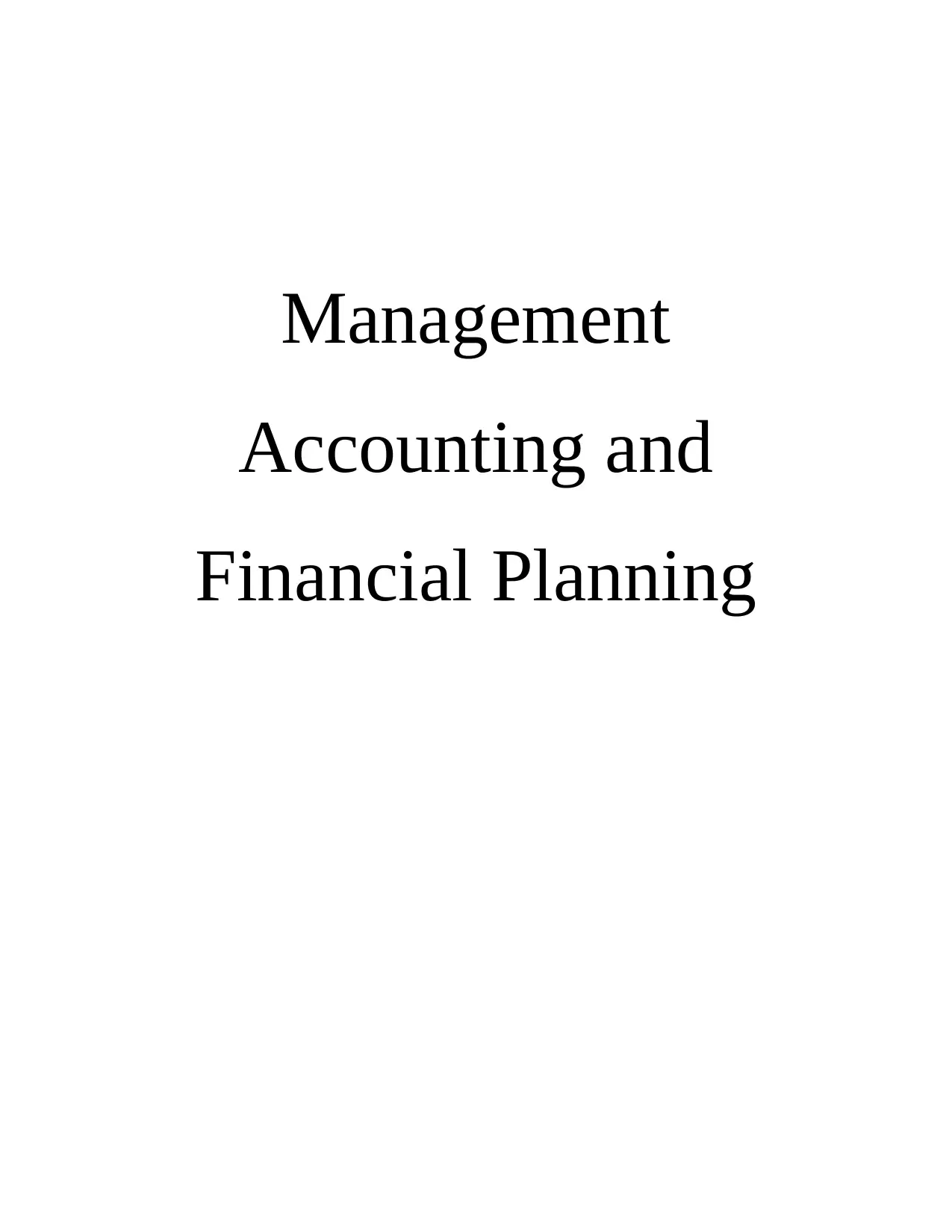
Management
Accounting and
Financial Planning
Accounting and
Financial Planning
Paraphrase This Document
Need a fresh take? Get an instant paraphrase of this document with our AI Paraphraser
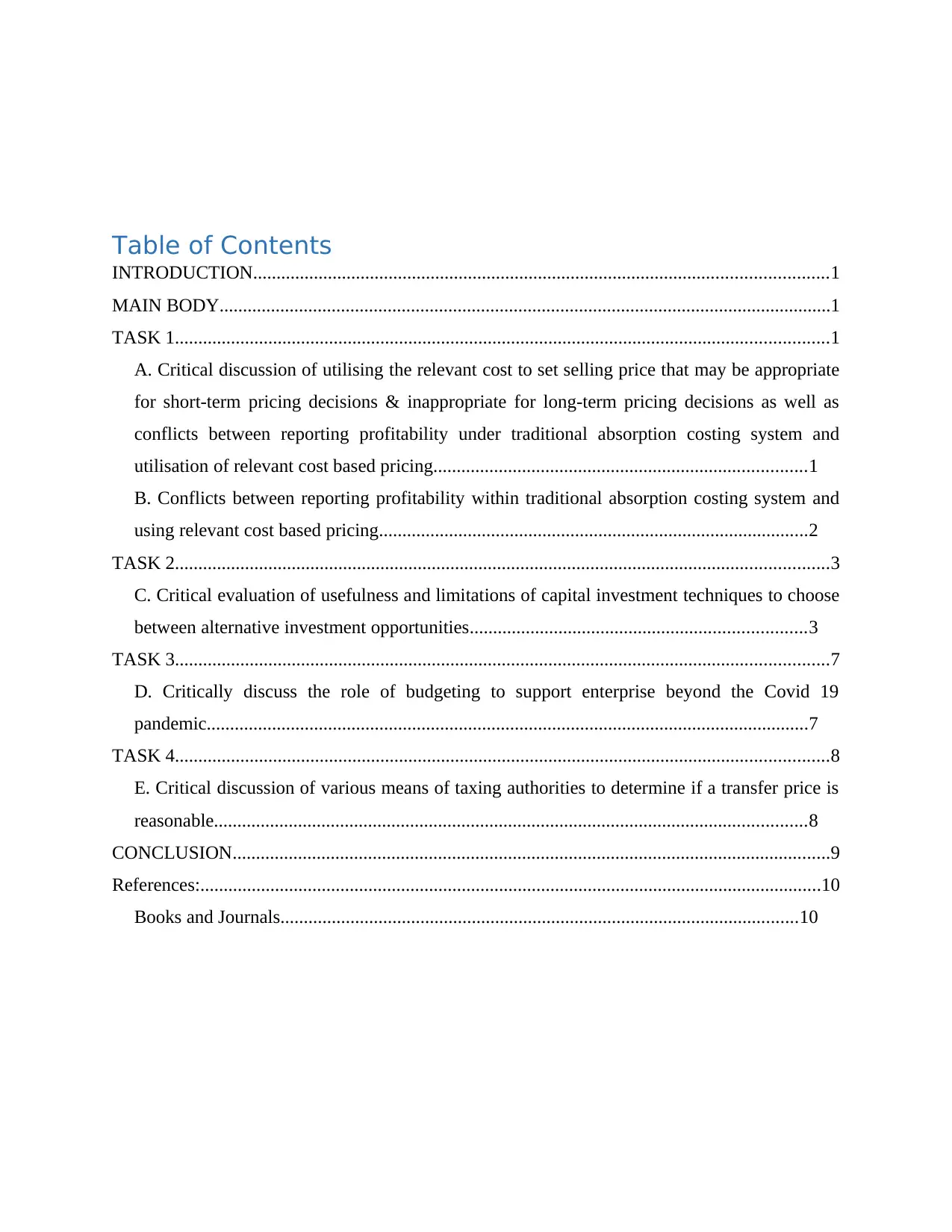
Table of Contents
INTRODUCTION...........................................................................................................................1
MAIN BODY...................................................................................................................................1
TASK 1............................................................................................................................................1
A. Critical discussion of utilising the relevant cost to set selling price that may be appropriate
for short-term pricing decisions & inappropriate for long-term pricing decisions as well as
conflicts between reporting profitability under traditional absorption costing system and
utilisation of relevant cost based pricing................................................................................1
B. Conflicts between reporting profitability within traditional absorption costing system and
using relevant cost based pricing............................................................................................2
TASK 2............................................................................................................................................3
C. Critical evaluation of usefulness and limitations of capital investment techniques to choose
between alternative investment opportunities........................................................................3
TASK 3............................................................................................................................................7
D. Critically discuss the role of budgeting to support enterprise beyond the Covid 19
pandemic.................................................................................................................................7
TASK 4............................................................................................................................................8
E. Critical discussion of various means of taxing authorities to determine if a transfer price is
reasonable...............................................................................................................................8
CONCLUSION................................................................................................................................9
References:.....................................................................................................................................10
Books and Journals...............................................................................................................10
INTRODUCTION...........................................................................................................................1
MAIN BODY...................................................................................................................................1
TASK 1............................................................................................................................................1
A. Critical discussion of utilising the relevant cost to set selling price that may be appropriate
for short-term pricing decisions & inappropriate for long-term pricing decisions as well as
conflicts between reporting profitability under traditional absorption costing system and
utilisation of relevant cost based pricing................................................................................1
B. Conflicts between reporting profitability within traditional absorption costing system and
using relevant cost based pricing............................................................................................2
TASK 2............................................................................................................................................3
C. Critical evaluation of usefulness and limitations of capital investment techniques to choose
between alternative investment opportunities........................................................................3
TASK 3............................................................................................................................................7
D. Critically discuss the role of budgeting to support enterprise beyond the Covid 19
pandemic.................................................................................................................................7
TASK 4............................................................................................................................................8
E. Critical discussion of various means of taxing authorities to determine if a transfer price is
reasonable...............................................................................................................................8
CONCLUSION................................................................................................................................9
References:.....................................................................................................................................10
Books and Journals...............................................................................................................10

INTRODUCTION
Management accounting refers to preparation of reports about the operations of business,
this help the organisation in making short term and long term decisions. Goals are achieved in
the business by identification, measurement, analysing information to the managers (Marota and
et al., 2017). Financial planning refers to a systematic approach to manage and control the
income and expenses. This report covers the discussion of strategies of short term and long term
in the business which helps them in setting prices. Capital investment techniques are also
discussed below with their usefulness and limitations. Along with the role of budgeting
technique in supporting the business during the time of COVID 19.
MAIN BODY
TASK 1
A. Critical discussion of utilising the relevant cost to set selling price that may be appropriate for
short-term pricing decisions & inappropriate for long-term pricing decisions as well as
conflicts between reporting profitability under traditional absorption costing system and
utilisation of relevant cost based pricing.
Relevant cost is a term of management accounting that tells the cost that pertain to a specific
decisions. This type of cost helps in elimination of information that are inessential in course of
business (Gutsalenko and et al., 2018). The motive behind this cost is to measure the objectivity
in the business. This cost is divided into four types, these four types of cost are discussed below:
Avoidable costs- This cost refers to the expenses which occur due to a specific activity, this
respective activity can be avoided in the business. Decline in this cost helps the business in
decreasing overall cost and maximizing the revenue of the business (Bochulia and Melnychenko,
2019). Avoidable cost are generally treated in period of short term as the company don’t disturb
the operations that run on a long term basis.
Future cash flow- This type of costing helps in estimating the expense that may occur in the
future course of business (Darma, 2018). A decline in the day to day cost will help in reducing
the actual cost of the products. Maintaining a short term cash flow is essential as the business
can’t exactly predict the cash scenario in a long term due to fluctuations and volatility in the
market conditions.
1
Management accounting refers to preparation of reports about the operations of business,
this help the organisation in making short term and long term decisions. Goals are achieved in
the business by identification, measurement, analysing information to the managers (Marota and
et al., 2017). Financial planning refers to a systematic approach to manage and control the
income and expenses. This report covers the discussion of strategies of short term and long term
in the business which helps them in setting prices. Capital investment techniques are also
discussed below with their usefulness and limitations. Along with the role of budgeting
technique in supporting the business during the time of COVID 19.
MAIN BODY
TASK 1
A. Critical discussion of utilising the relevant cost to set selling price that may be appropriate for
short-term pricing decisions & inappropriate for long-term pricing decisions as well as
conflicts between reporting profitability under traditional absorption costing system and
utilisation of relevant cost based pricing.
Relevant cost is a term of management accounting that tells the cost that pertain to a specific
decisions. This type of cost helps in elimination of information that are inessential in course of
business (Gutsalenko and et al., 2018). The motive behind this cost is to measure the objectivity
in the business. This cost is divided into four types, these four types of cost are discussed below:
Avoidable costs- This cost refers to the expenses which occur due to a specific activity, this
respective activity can be avoided in the business. Decline in this cost helps the business in
decreasing overall cost and maximizing the revenue of the business (Bochulia and Melnychenko,
2019). Avoidable cost are generally treated in period of short term as the company don’t disturb
the operations that run on a long term basis.
Future cash flow- This type of costing helps in estimating the expense that may occur in the
future course of business (Darma, 2018). A decline in the day to day cost will help in reducing
the actual cost of the products. Maintaining a short term cash flow is essential as the business
can’t exactly predict the cash scenario in a long term due to fluctuations and volatility in the
market conditions.
1
⊘ This is a preview!⊘
Do you want full access?
Subscribe today to unlock all pages.

Trusted by 1+ million students worldwide
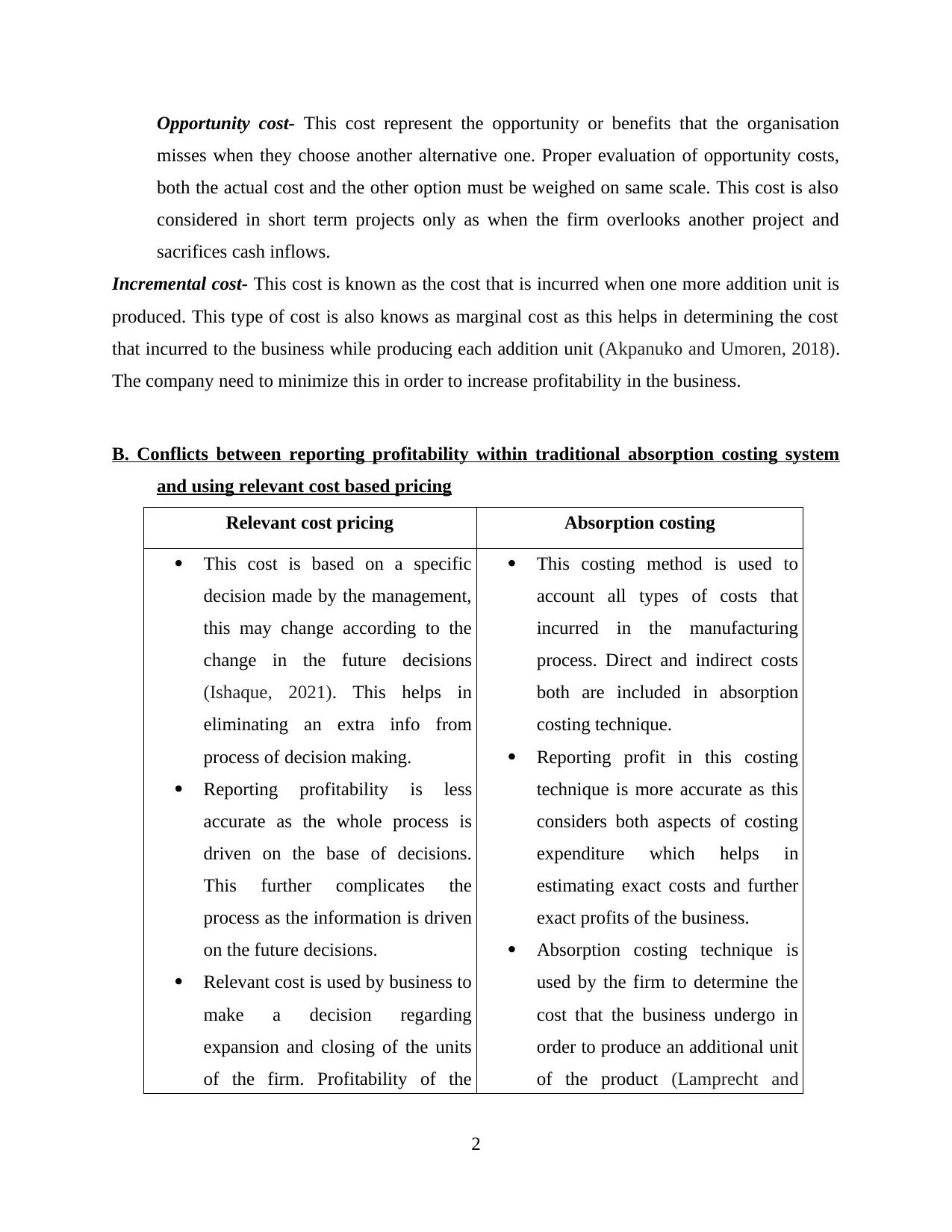
Opportunity cost- This cost represent the opportunity or benefits that the organisation
misses when they choose another alternative one. Proper evaluation of opportunity costs,
both the actual cost and the other option must be weighed on same scale. This cost is also
considered in short term projects only as when the firm overlooks another project and
sacrifices cash inflows.
Incremental cost- This cost is known as the cost that is incurred when one more addition unit is
produced. This type of cost is also knows as marginal cost as this helps in determining the cost
that incurred to the business while producing each addition unit (Akpanuko and Umoren, 2018).
The company need to minimize this in order to increase profitability in the business.
B. Conflicts between reporting profitability within traditional absorption costing system
and using relevant cost based pricing
Relevant cost pricing Absorption costing
This cost is based on a specific
decision made by the management,
this may change according to the
change in the future decisions
(Ishaque, 2021). This helps in
eliminating an extra info from
process of decision making.
Reporting profitability is less
accurate as the whole process is
driven on the base of decisions.
This further complicates the
process as the information is driven
on the future decisions.
Relevant cost is used by business to
make a decision regarding
expansion and closing of the units
of the firm. Profitability of the
This costing method is used to
account all types of costs that
incurred in the manufacturing
process. Direct and indirect costs
both are included in absorption
costing technique.
Reporting profit in this costing
technique is more accurate as this
considers both aspects of costing
expenditure which helps in
estimating exact costs and further
exact profits of the business.
Absorption costing technique is
used by the firm to determine the
cost that the business undergo in
order to produce an additional unit
of the product (Lamprecht and
2
misses when they choose another alternative one. Proper evaluation of opportunity costs,
both the actual cost and the other option must be weighed on same scale. This cost is also
considered in short term projects only as when the firm overlooks another project and
sacrifices cash inflows.
Incremental cost- This cost is known as the cost that is incurred when one more addition unit is
produced. This type of cost is also knows as marginal cost as this helps in determining the cost
that incurred to the business while producing each addition unit (Akpanuko and Umoren, 2018).
The company need to minimize this in order to increase profitability in the business.
B. Conflicts between reporting profitability within traditional absorption costing system
and using relevant cost based pricing
Relevant cost pricing Absorption costing
This cost is based on a specific
decision made by the management,
this may change according to the
change in the future decisions
(Ishaque, 2021). This helps in
eliminating an extra info from
process of decision making.
Reporting profitability is less
accurate as the whole process is
driven on the base of decisions.
This further complicates the
process as the information is driven
on the future decisions.
Relevant cost is used by business to
make a decision regarding
expansion and closing of the units
of the firm. Profitability of the
This costing method is used to
account all types of costs that
incurred in the manufacturing
process. Direct and indirect costs
both are included in absorption
costing technique.
Reporting profit in this costing
technique is more accurate as this
considers both aspects of costing
expenditure which helps in
estimating exact costs and further
exact profits of the business.
Absorption costing technique is
used by the firm to determine the
cost that the business undergo in
order to produce an additional unit
of the product (Lamprecht and
2
Paraphrase This Document
Need a fresh take? Get an instant paraphrase of this document with our AI Paraphraser
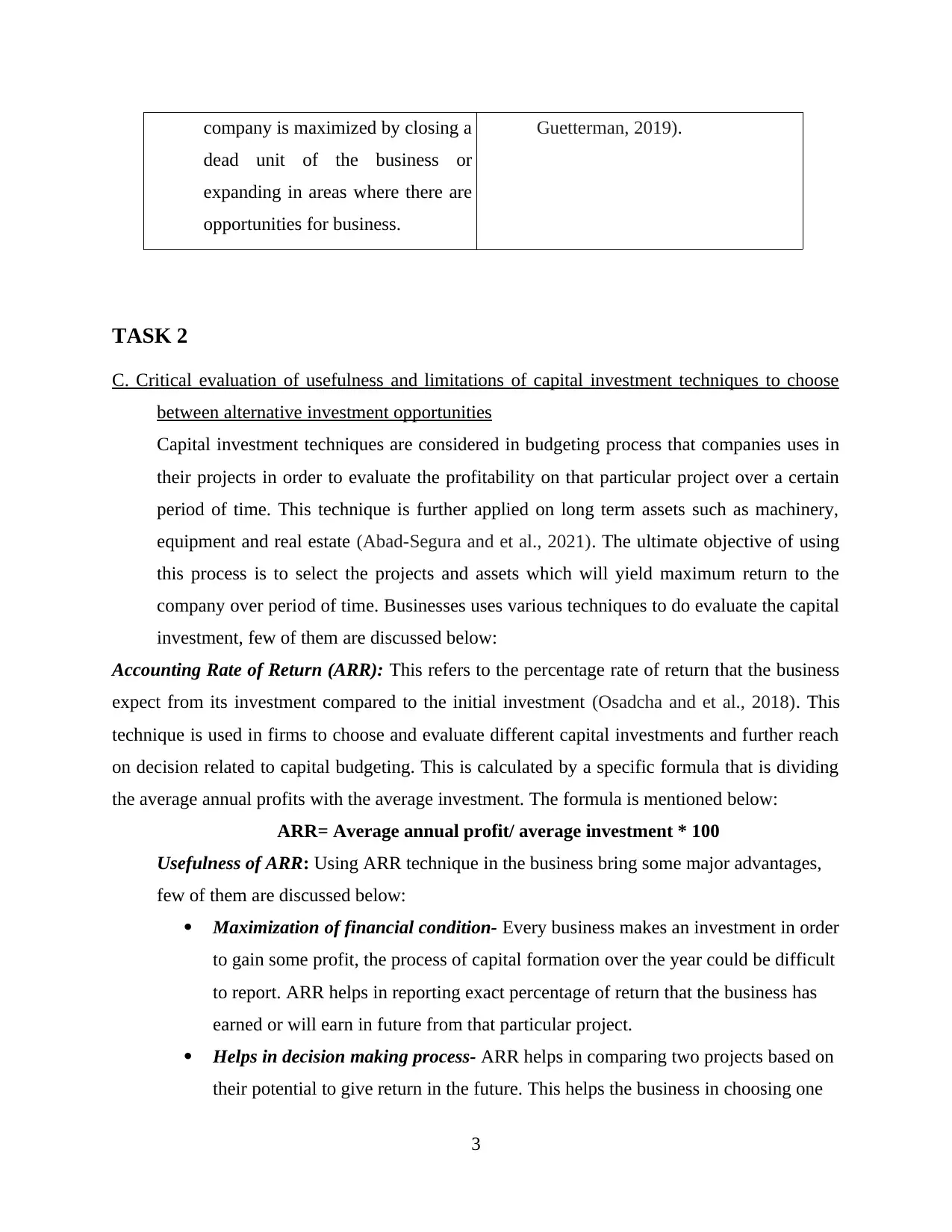
company is maximized by closing a
dead unit of the business or
expanding in areas where there are
opportunities for business.
Guetterman, 2019).
TASK 2
C. Critical evaluation of usefulness and limitations of capital investment techniques to choose
between alternative investment opportunities
Capital investment techniques are considered in budgeting process that companies uses in
their projects in order to evaluate the profitability on that particular project over a certain
period of time. This technique is further applied on long term assets such as machinery,
equipment and real estate (Abad-Segura and et al., 2021). The ultimate objective of using
this process is to select the projects and assets which will yield maximum return to the
company over period of time. Businesses uses various techniques to do evaluate the capital
investment, few of them are discussed below:
Accounting Rate of Return (ARR): This refers to the percentage rate of return that the business
expect from its investment compared to the initial investment (Osadcha and et al., 2018). This
technique is used in firms to choose and evaluate different capital investments and further reach
on decision related to capital budgeting. This is calculated by a specific formula that is dividing
the average annual profits with the average investment. The formula is mentioned below:
ARR= Average annual profit/ average investment * 100
Usefulness of ARR: Using ARR technique in the business bring some major advantages,
few of them are discussed below:
Maximization of financial condition- Every business makes an investment in order
to gain some profit, the process of capital formation over the year could be difficult
to report. ARR helps in reporting exact percentage of return that the business has
earned or will earn in future from that particular project.
Helps in decision making process- ARR helps in comparing two projects based on
their potential to give return in the future. This helps the business in choosing one
3
dead unit of the business or
expanding in areas where there are
opportunities for business.
Guetterman, 2019).
TASK 2
C. Critical evaluation of usefulness and limitations of capital investment techniques to choose
between alternative investment opportunities
Capital investment techniques are considered in budgeting process that companies uses in
their projects in order to evaluate the profitability on that particular project over a certain
period of time. This technique is further applied on long term assets such as machinery,
equipment and real estate (Abad-Segura and et al., 2021). The ultimate objective of using
this process is to select the projects and assets which will yield maximum return to the
company over period of time. Businesses uses various techniques to do evaluate the capital
investment, few of them are discussed below:
Accounting Rate of Return (ARR): This refers to the percentage rate of return that the business
expect from its investment compared to the initial investment (Osadcha and et al., 2018). This
technique is used in firms to choose and evaluate different capital investments and further reach
on decision related to capital budgeting. This is calculated by a specific formula that is dividing
the average annual profits with the average investment. The formula is mentioned below:
ARR= Average annual profit/ average investment * 100
Usefulness of ARR: Using ARR technique in the business bring some major advantages,
few of them are discussed below:
Maximization of financial condition- Every business makes an investment in order
to gain some profit, the process of capital formation over the year could be difficult
to report. ARR helps in reporting exact percentage of return that the business has
earned or will earn in future from that particular project.
Helps in decision making process- ARR helps in comparing two projects based on
their potential to give return in the future. This helps the business in choosing one
3
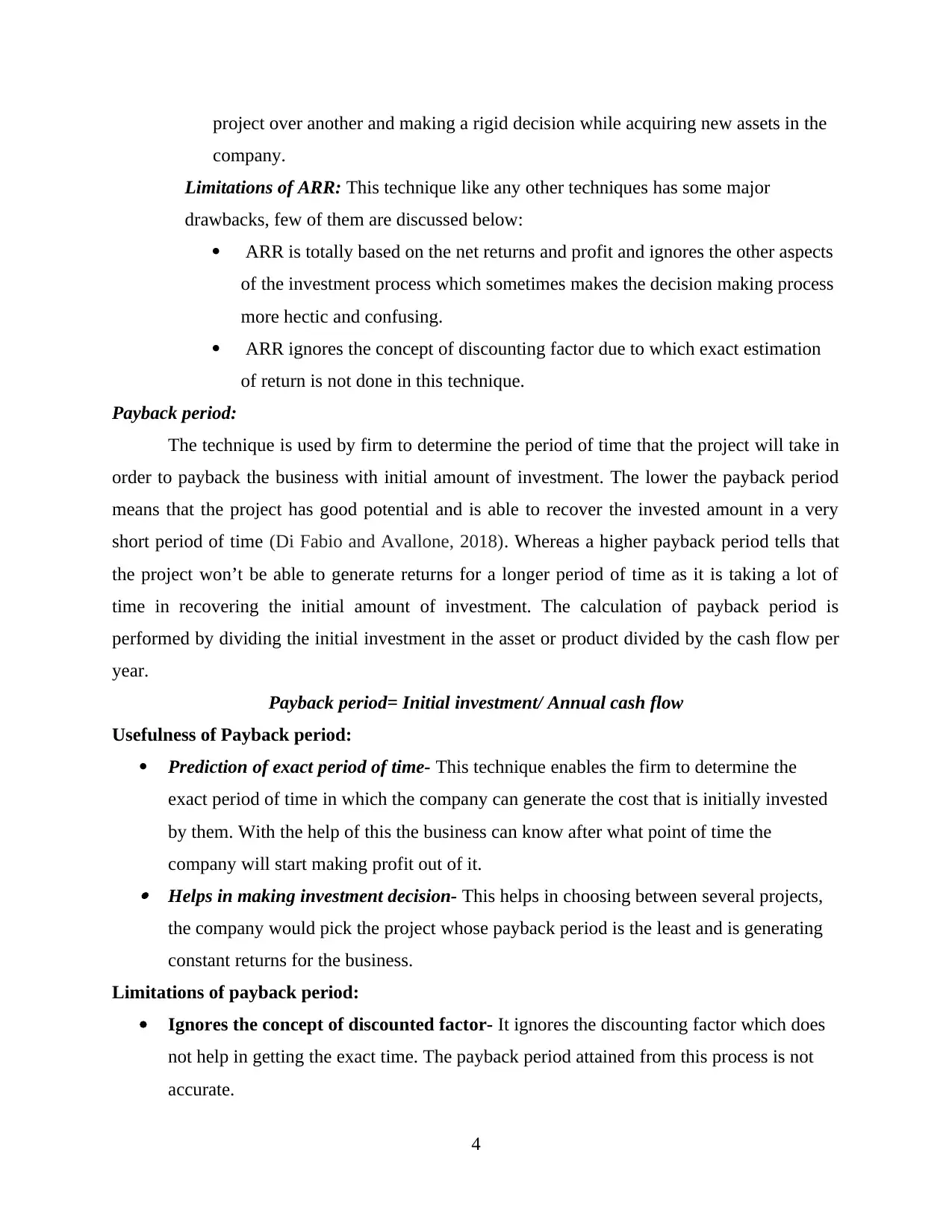
project over another and making a rigid decision while acquiring new assets in the
company.
Limitations of ARR: This technique like any other techniques has some major
drawbacks, few of them are discussed below:
ARR is totally based on the net returns and profit and ignores the other aspects
of the investment process which sometimes makes the decision making process
more hectic and confusing.
ARR ignores the concept of discounting factor due to which exact estimation
of return is not done in this technique.
Payback period:
The technique is used by firm to determine the period of time that the project will take in
order to payback the business with initial amount of investment. The lower the payback period
means that the project has good potential and is able to recover the invested amount in a very
short period of time (Di Fabio and Avallone, 2018). Whereas a higher payback period tells that
the project won’t be able to generate returns for a longer period of time as it is taking a lot of
time in recovering the initial amount of investment. The calculation of payback period is
performed by dividing the initial investment in the asset or product divided by the cash flow per
year.
Payback period= Initial investment/ Annual cash flow
Usefulness of Payback period:
Prediction of exact period of time- This technique enables the firm to determine the
exact period of time in which the company can generate the cost that is initially invested
by them. With the help of this the business can know after what point of time the
company will start making profit out of it. Helps in making investment decision- This helps in choosing between several projects,
the company would pick the project whose payback period is the least and is generating
constant returns for the business.
Limitations of payback period:
Ignores the concept of discounted factor- It ignores the discounting factor which does
not help in getting the exact time. The payback period attained from this process is not
accurate.
4
company.
Limitations of ARR: This technique like any other techniques has some major
drawbacks, few of them are discussed below:
ARR is totally based on the net returns and profit and ignores the other aspects
of the investment process which sometimes makes the decision making process
more hectic and confusing.
ARR ignores the concept of discounting factor due to which exact estimation
of return is not done in this technique.
Payback period:
The technique is used by firm to determine the period of time that the project will take in
order to payback the business with initial amount of investment. The lower the payback period
means that the project has good potential and is able to recover the invested amount in a very
short period of time (Di Fabio and Avallone, 2018). Whereas a higher payback period tells that
the project won’t be able to generate returns for a longer period of time as it is taking a lot of
time in recovering the initial amount of investment. The calculation of payback period is
performed by dividing the initial investment in the asset or product divided by the cash flow per
year.
Payback period= Initial investment/ Annual cash flow
Usefulness of Payback period:
Prediction of exact period of time- This technique enables the firm to determine the
exact period of time in which the company can generate the cost that is initially invested
by them. With the help of this the business can know after what point of time the
company will start making profit out of it. Helps in making investment decision- This helps in choosing between several projects,
the company would pick the project whose payback period is the least and is generating
constant returns for the business.
Limitations of payback period:
Ignores the concept of discounted factor- It ignores the discounting factor which does
not help in getting the exact time. The payback period attained from this process is not
accurate.
4
⊘ This is a preview!⊘
Do you want full access?
Subscribe today to unlock all pages.

Trusted by 1+ million students worldwide
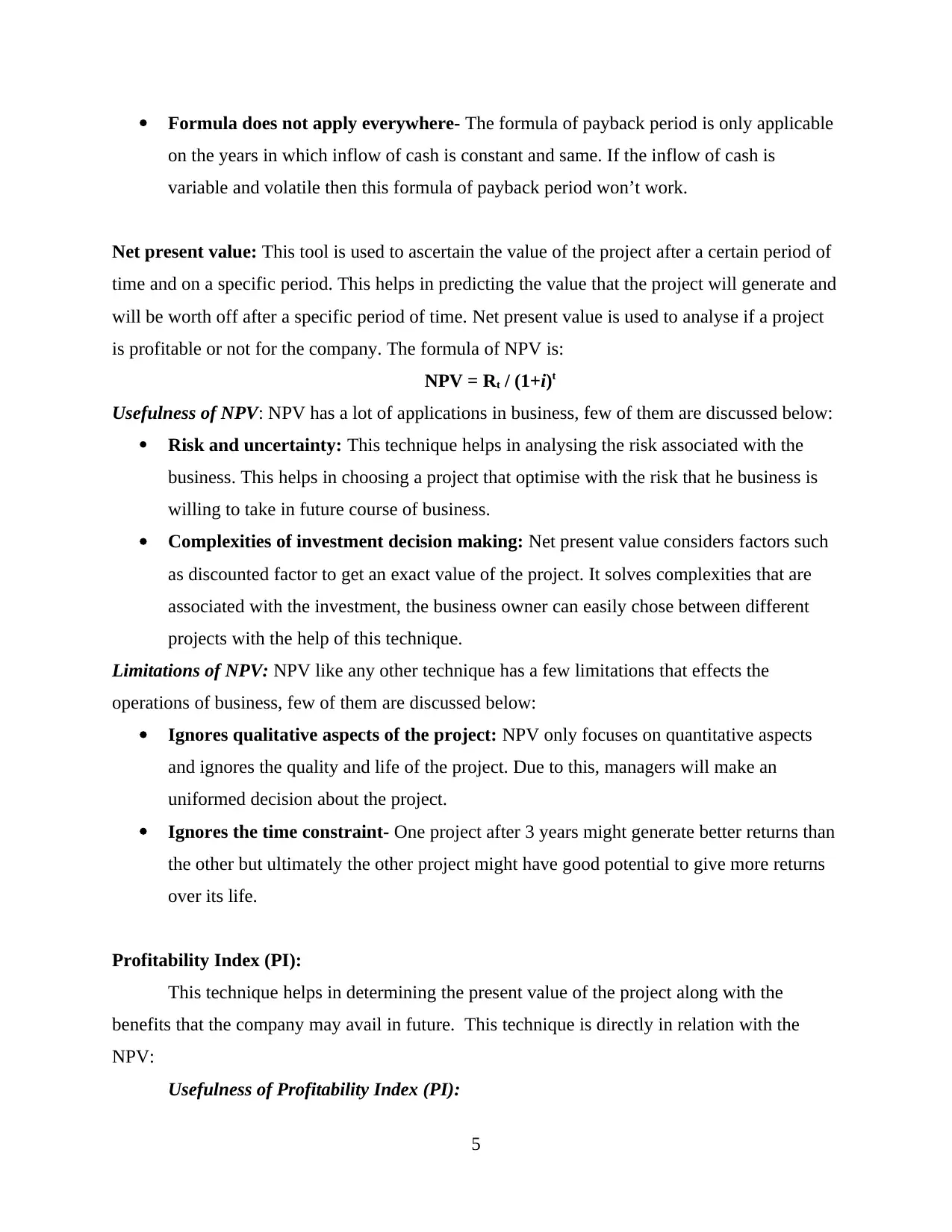
Formula does not apply everywhere- The formula of payback period is only applicable
on the years in which inflow of cash is constant and same. If the inflow of cash is
variable and volatile then this formula of payback period won’t work.
Net present value: This tool is used to ascertain the value of the project after a certain period of
time and on a specific period. This helps in predicting the value that the project will generate and
will be worth off after a specific period of time. Net present value is used to analyse if a project
is profitable or not for the company. The formula of NPV is:
NPV = Rt / (1+i)t
Usefulness of NPV: NPV has a lot of applications in business, few of them are discussed below:
Risk and uncertainty: This technique helps in analysing the risk associated with the
business. This helps in choosing a project that optimise with the risk that he business is
willing to take in future course of business.
Complexities of investment decision making: Net present value considers factors such
as discounted factor to get an exact value of the project. It solves complexities that are
associated with the investment, the business owner can easily chose between different
projects with the help of this technique.
Limitations of NPV: NPV like any other technique has a few limitations that effects the
operations of business, few of them are discussed below:
Ignores qualitative aspects of the project: NPV only focuses on quantitative aspects
and ignores the quality and life of the project. Due to this, managers will make an
uniformed decision about the project.
Ignores the time constraint- One project after 3 years might generate better returns than
the other but ultimately the other project might have good potential to give more returns
over its life.
Profitability Index (PI):
This technique helps in determining the present value of the project along with the
benefits that the company may avail in future. This technique is directly in relation with the
NPV:
Usefulness of Profitability Index (PI):
5
on the years in which inflow of cash is constant and same. If the inflow of cash is
variable and volatile then this formula of payback period won’t work.
Net present value: This tool is used to ascertain the value of the project after a certain period of
time and on a specific period. This helps in predicting the value that the project will generate and
will be worth off after a specific period of time. Net present value is used to analyse if a project
is profitable or not for the company. The formula of NPV is:
NPV = Rt / (1+i)t
Usefulness of NPV: NPV has a lot of applications in business, few of them are discussed below:
Risk and uncertainty: This technique helps in analysing the risk associated with the
business. This helps in choosing a project that optimise with the risk that he business is
willing to take in future course of business.
Complexities of investment decision making: Net present value considers factors such
as discounted factor to get an exact value of the project. It solves complexities that are
associated with the investment, the business owner can easily chose between different
projects with the help of this technique.
Limitations of NPV: NPV like any other technique has a few limitations that effects the
operations of business, few of them are discussed below:
Ignores qualitative aspects of the project: NPV only focuses on quantitative aspects
and ignores the quality and life of the project. Due to this, managers will make an
uniformed decision about the project.
Ignores the time constraint- One project after 3 years might generate better returns than
the other but ultimately the other project might have good potential to give more returns
over its life.
Profitability Index (PI):
This technique helps in determining the present value of the project along with the
benefits that the company may avail in future. This technique is directly in relation with the
NPV:
Usefulness of Profitability Index (PI):
5
Paraphrase This Document
Need a fresh take? Get an instant paraphrase of this document with our AI Paraphraser

Control on expenses: This technique helps in managing the expenses as the profitability
index is more concerned about the income of the business (Jovanović and Vašiček,
2021). This looks if an investment has enough potential to increase the value of firm or
not.
Helps in comparing the time value of cash flows, this helps in determining the exact
value that the investment could yield to business.
Limitations of Profitability Index (PI):
Sunk cost of the investment is generally ignored while using this technique therefore the
company is not able to estimate the exact value of return from the investment
(Ramachandran and Kakani, 2020).
The information that is generated in by using this technique is based just on estimates and
therefore has a chance that the decision making process in this criteria is not correct.
Internal Rate of Return (IRR): This calculation is used by businesses to determine if a
particular investment is worth investing or not (Stockenstrand and Nilsson, 2017). The
assessment of this factor is done on the basis of interest that is yielded over the years on the
capital investment. The ideal internal rate of return should sum up to greater than the cost of
capital invested in that.
Usefulness of Internal rate of return (IRR): Choosing a project: IRR is helpful in choosing between two or projects as the rate of
return tells which project will be beneficial for the company in long term aspects. A
project with higher ARR is chosen over the project with a lower one. Can be mix used: IRR can be used with other capital investment techniques in order to
gain a more real and correct insight on the investment. With the help of this managers can
make correct decisions on the basis of several techniques.
Limitations of Internal Rate of Return (IRR):
Ignores the duration of project: This techniques does not take the lifecycle and
duration of the project and only takes the value of project in consideration. If a company
has two projects with an IRR of 15% and 20% respectively then the company will chose
the second one, ignoring the fact that the first one is of a longer term and will be able to
generate more revenue for the company.
6
index is more concerned about the income of the business (Jovanović and Vašiček,
2021). This looks if an investment has enough potential to increase the value of firm or
not.
Helps in comparing the time value of cash flows, this helps in determining the exact
value that the investment could yield to business.
Limitations of Profitability Index (PI):
Sunk cost of the investment is generally ignored while using this technique therefore the
company is not able to estimate the exact value of return from the investment
(Ramachandran and Kakani, 2020).
The information that is generated in by using this technique is based just on estimates and
therefore has a chance that the decision making process in this criteria is not correct.
Internal Rate of Return (IRR): This calculation is used by businesses to determine if a
particular investment is worth investing or not (Stockenstrand and Nilsson, 2017). The
assessment of this factor is done on the basis of interest that is yielded over the years on the
capital investment. The ideal internal rate of return should sum up to greater than the cost of
capital invested in that.
Usefulness of Internal rate of return (IRR): Choosing a project: IRR is helpful in choosing between two or projects as the rate of
return tells which project will be beneficial for the company in long term aspects. A
project with higher ARR is chosen over the project with a lower one. Can be mix used: IRR can be used with other capital investment techniques in order to
gain a more real and correct insight on the investment. With the help of this managers can
make correct decisions on the basis of several techniques.
Limitations of Internal Rate of Return (IRR):
Ignores the duration of project: This techniques does not take the lifecycle and
duration of the project and only takes the value of project in consideration. If a company
has two projects with an IRR of 15% and 20% respectively then the company will chose
the second one, ignoring the fact that the first one is of a longer term and will be able to
generate more revenue for the company.
6
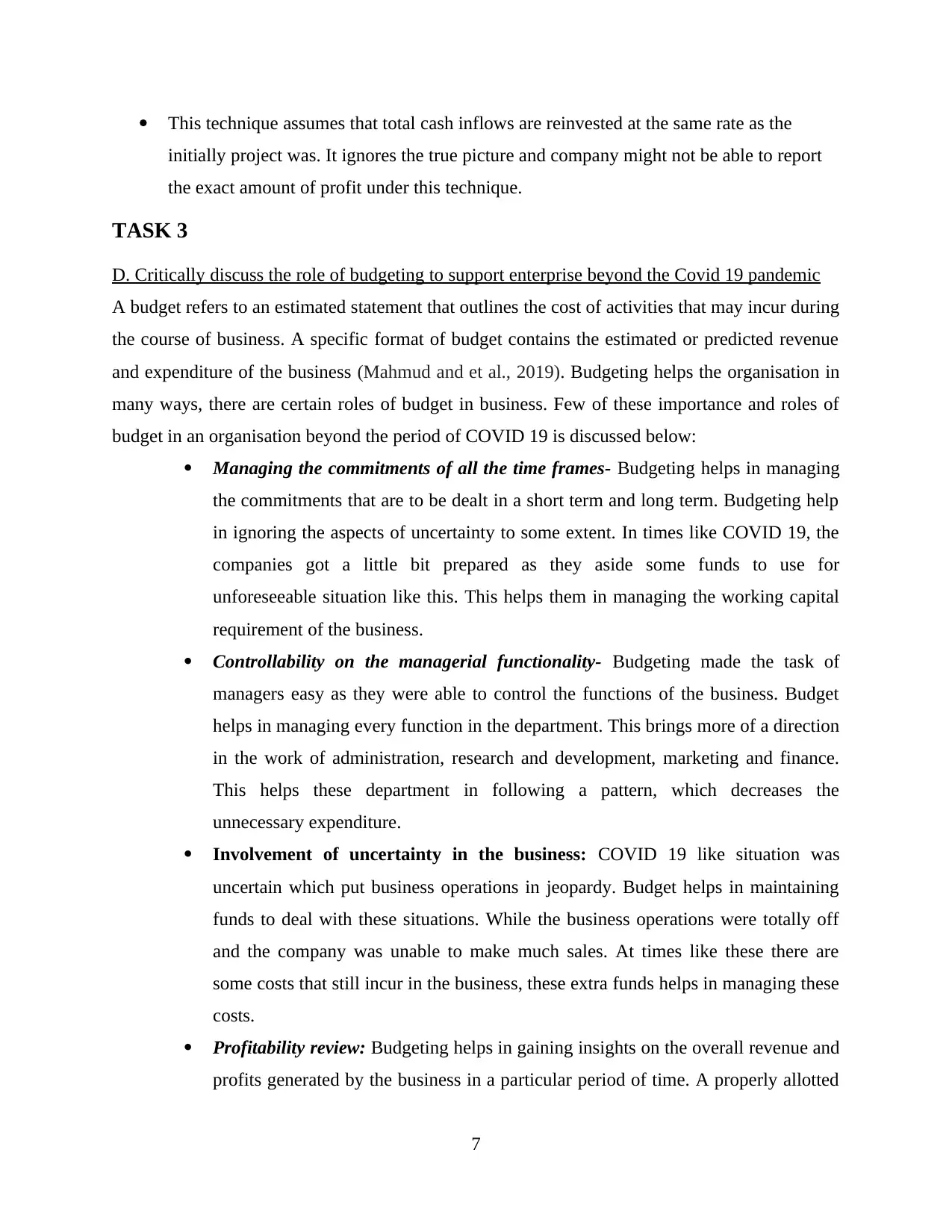
This technique assumes that total cash inflows are reinvested at the same rate as the
initially project was. It ignores the true picture and company might not be able to report
the exact amount of profit under this technique.
TASK 3
D. Critically discuss the role of budgeting to support enterprise beyond the Covid 19 pandemic
A budget refers to an estimated statement that outlines the cost of activities that may incur during
the course of business. A specific format of budget contains the estimated or predicted revenue
and expenditure of the business (Mahmud and et al., 2019). Budgeting helps the organisation in
many ways, there are certain roles of budget in business. Few of these importance and roles of
budget in an organisation beyond the period of COVID 19 is discussed below:
Managing the commitments of all the time frames- Budgeting helps in managing
the commitments that are to be dealt in a short term and long term. Budgeting help
in ignoring the aspects of uncertainty to some extent. In times like COVID 19, the
companies got a little bit prepared as they aside some funds to use for
unforeseeable situation like this. This helps them in managing the working capital
requirement of the business.
Controllability on the managerial functionality- Budgeting made the task of
managers easy as they were able to control the functions of the business. Budget
helps in managing every function in the department. This brings more of a direction
in the work of administration, research and development, marketing and finance.
This helps these department in following a pattern, which decreases the
unnecessary expenditure.
Involvement of uncertainty in the business: COVID 19 like situation was
uncertain which put business operations in jeopardy. Budget helps in maintaining
funds to deal with these situations. While the business operations were totally off
and the company was unable to make much sales. At times like these there are
some costs that still incur in the business, these extra funds helps in managing these
costs.
Profitability review: Budgeting helps in gaining insights on the overall revenue and
profits generated by the business in a particular period of time. A properly allotted
7
initially project was. It ignores the true picture and company might not be able to report
the exact amount of profit under this technique.
TASK 3
D. Critically discuss the role of budgeting to support enterprise beyond the Covid 19 pandemic
A budget refers to an estimated statement that outlines the cost of activities that may incur during
the course of business. A specific format of budget contains the estimated or predicted revenue
and expenditure of the business (Mahmud and et al., 2019). Budgeting helps the organisation in
many ways, there are certain roles of budget in business. Few of these importance and roles of
budget in an organisation beyond the period of COVID 19 is discussed below:
Managing the commitments of all the time frames- Budgeting helps in managing
the commitments that are to be dealt in a short term and long term. Budgeting help
in ignoring the aspects of uncertainty to some extent. In times like COVID 19, the
companies got a little bit prepared as they aside some funds to use for
unforeseeable situation like this. This helps them in managing the working capital
requirement of the business.
Controllability on the managerial functionality- Budgeting made the task of
managers easy as they were able to control the functions of the business. Budget
helps in managing every function in the department. This brings more of a direction
in the work of administration, research and development, marketing and finance.
This helps these department in following a pattern, which decreases the
unnecessary expenditure.
Involvement of uncertainty in the business: COVID 19 like situation was
uncertain which put business operations in jeopardy. Budget helps in maintaining
funds to deal with these situations. While the business operations were totally off
and the company was unable to make much sales. At times like these there are
some costs that still incur in the business, these extra funds helps in managing these
costs.
Profitability review: Budgeting helps in gaining insights on the overall revenue and
profits generated by the business in a particular period of time. A properly allotted
7
⊘ This is a preview!⊘
Do you want full access?
Subscribe today to unlock all pages.

Trusted by 1+ million students worldwide
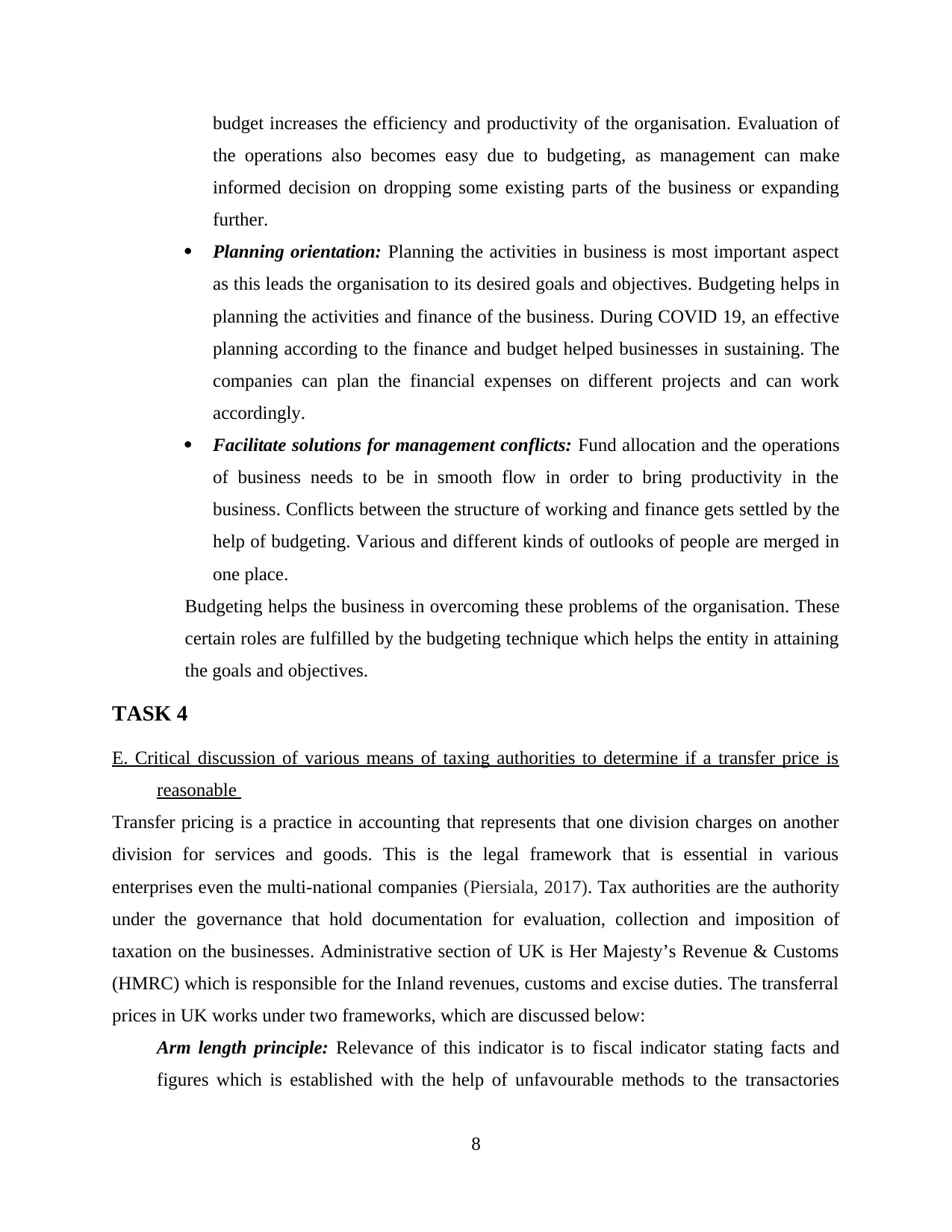
budget increases the efficiency and productivity of the organisation. Evaluation of
the operations also becomes easy due to budgeting, as management can make
informed decision on dropping some existing parts of the business or expanding
further.
Planning orientation: Planning the activities in business is most important aspect
as this leads the organisation to its desired goals and objectives. Budgeting helps in
planning the activities and finance of the business. During COVID 19, an effective
planning according to the finance and budget helped businesses in sustaining. The
companies can plan the financial expenses on different projects and can work
accordingly.
Facilitate solutions for management conflicts: Fund allocation and the operations
of business needs to be in smooth flow in order to bring productivity in the
business. Conflicts between the structure of working and finance gets settled by the
help of budgeting. Various and different kinds of outlooks of people are merged in
one place.
Budgeting helps the business in overcoming these problems of the organisation. These
certain roles are fulfilled by the budgeting technique which helps the entity in attaining
the goals and objectives.
TASK 4
E. Critical discussion of various means of taxing authorities to determine if a transfer price is
reasonable
Transfer pricing is a practice in accounting that represents that one division charges on another
division for services and goods. This is the legal framework that is essential in various
enterprises even the multi-national companies (Piersiala, 2017). Tax authorities are the authority
under the governance that hold documentation for evaluation, collection and imposition of
taxation on the businesses. Administrative section of UK is Her Majesty’s Revenue & Customs
(HMRC) which is responsible for the Inland revenues, customs and excise duties. The transferral
prices in UK works under two frameworks, which are discussed below:
Arm length principle: Relevance of this indicator is to fiscal indicator stating facts and
figures which is established with the help of unfavourable methods to the transactories
8
the operations also becomes easy due to budgeting, as management can make
informed decision on dropping some existing parts of the business or expanding
further.
Planning orientation: Planning the activities in business is most important aspect
as this leads the organisation to its desired goals and objectives. Budgeting helps in
planning the activities and finance of the business. During COVID 19, an effective
planning according to the finance and budget helped businesses in sustaining. The
companies can plan the financial expenses on different projects and can work
accordingly.
Facilitate solutions for management conflicts: Fund allocation and the operations
of business needs to be in smooth flow in order to bring productivity in the
business. Conflicts between the structure of working and finance gets settled by the
help of budgeting. Various and different kinds of outlooks of people are merged in
one place.
Budgeting helps the business in overcoming these problems of the organisation. These
certain roles are fulfilled by the budgeting technique which helps the entity in attaining
the goals and objectives.
TASK 4
E. Critical discussion of various means of taxing authorities to determine if a transfer price is
reasonable
Transfer pricing is a practice in accounting that represents that one division charges on another
division for services and goods. This is the legal framework that is essential in various
enterprises even the multi-national companies (Piersiala, 2017). Tax authorities are the authority
under the governance that hold documentation for evaluation, collection and imposition of
taxation on the businesses. Administrative section of UK is Her Majesty’s Revenue & Customs
(HMRC) which is responsible for the Inland revenues, customs and excise duties. The transferral
prices in UK works under two frameworks, which are discussed below:
Arm length principle: Relevance of this indicator is to fiscal indicator stating facts and
figures which is established with the help of unfavourable methods to the transactories
8
Paraphrase This Document
Need a fresh take? Get an instant paraphrase of this document with our AI Paraphraser
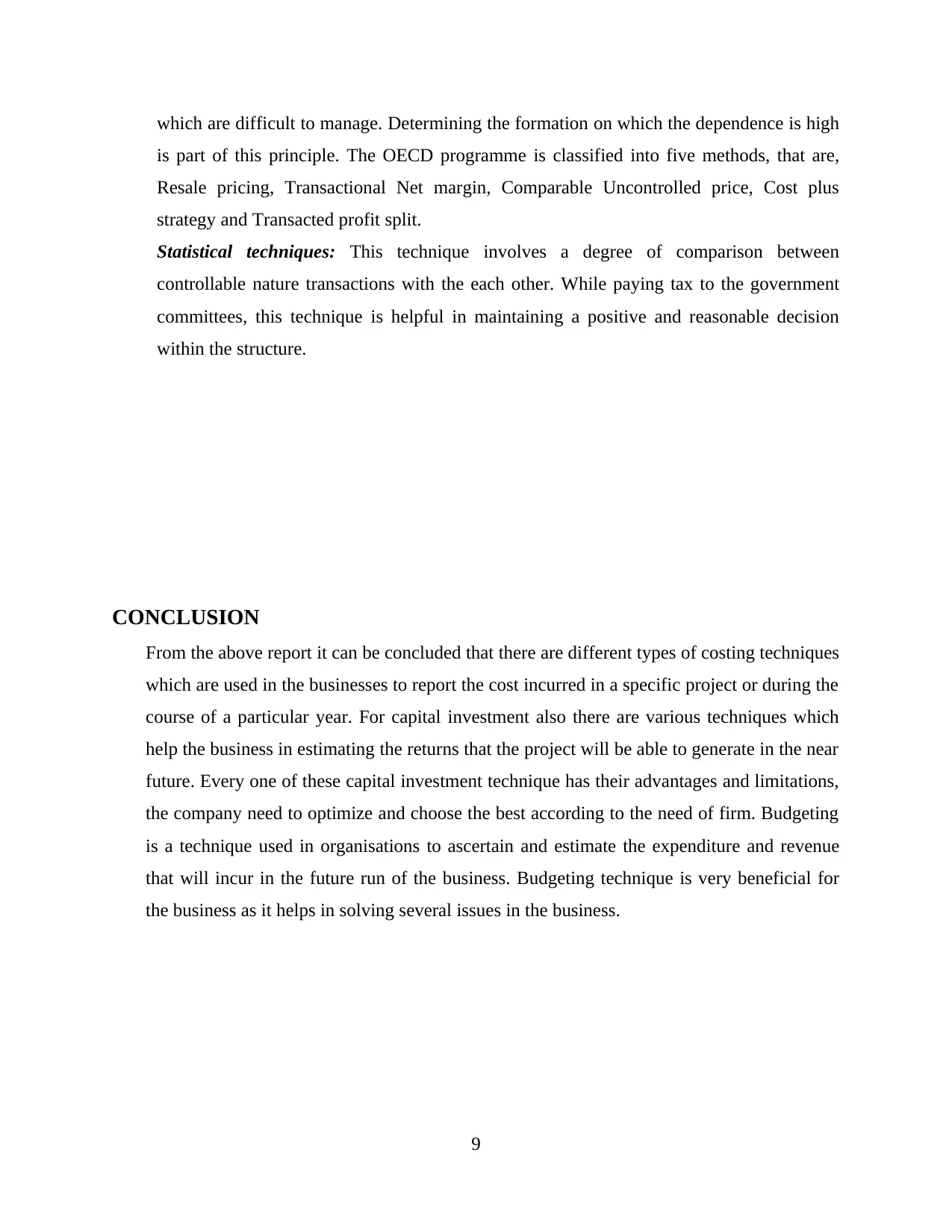
which are difficult to manage. Determining the formation on which the dependence is high
is part of this principle. The OECD programme is classified into five methods, that are,
Resale pricing, Transactional Net margin, Comparable Uncontrolled price, Cost plus
strategy and Transacted profit split.
Statistical techniques: This technique involves a degree of comparison between
controllable nature transactions with the each other. While paying tax to the government
committees, this technique is helpful in maintaining a positive and reasonable decision
within the structure.
CONCLUSION
From the above report it can be concluded that there are different types of costing techniques
which are used in the businesses to report the cost incurred in a specific project or during the
course of a particular year. For capital investment also there are various techniques which
help the business in estimating the returns that the project will be able to generate in the near
future. Every one of these capital investment technique has their advantages and limitations,
the company need to optimize and choose the best according to the need of firm. Budgeting
is a technique used in organisations to ascertain and estimate the expenditure and revenue
that will incur in the future run of the business. Budgeting technique is very beneficial for
the business as it helps in solving several issues in the business.
9
is part of this principle. The OECD programme is classified into five methods, that are,
Resale pricing, Transactional Net margin, Comparable Uncontrolled price, Cost plus
strategy and Transacted profit split.
Statistical techniques: This technique involves a degree of comparison between
controllable nature transactions with the each other. While paying tax to the government
committees, this technique is helpful in maintaining a positive and reasonable decision
within the structure.
CONCLUSION
From the above report it can be concluded that there are different types of costing techniques
which are used in the businesses to report the cost incurred in a specific project or during the
course of a particular year. For capital investment also there are various techniques which
help the business in estimating the returns that the project will be able to generate in the near
future. Every one of these capital investment technique has their advantages and limitations,
the company need to optimize and choose the best according to the need of firm. Budgeting
is a technique used in organisations to ascertain and estimate the expenditure and revenue
that will incur in the future run of the business. Budgeting technique is very beneficial for
the business as it helps in solving several issues in the business.
9
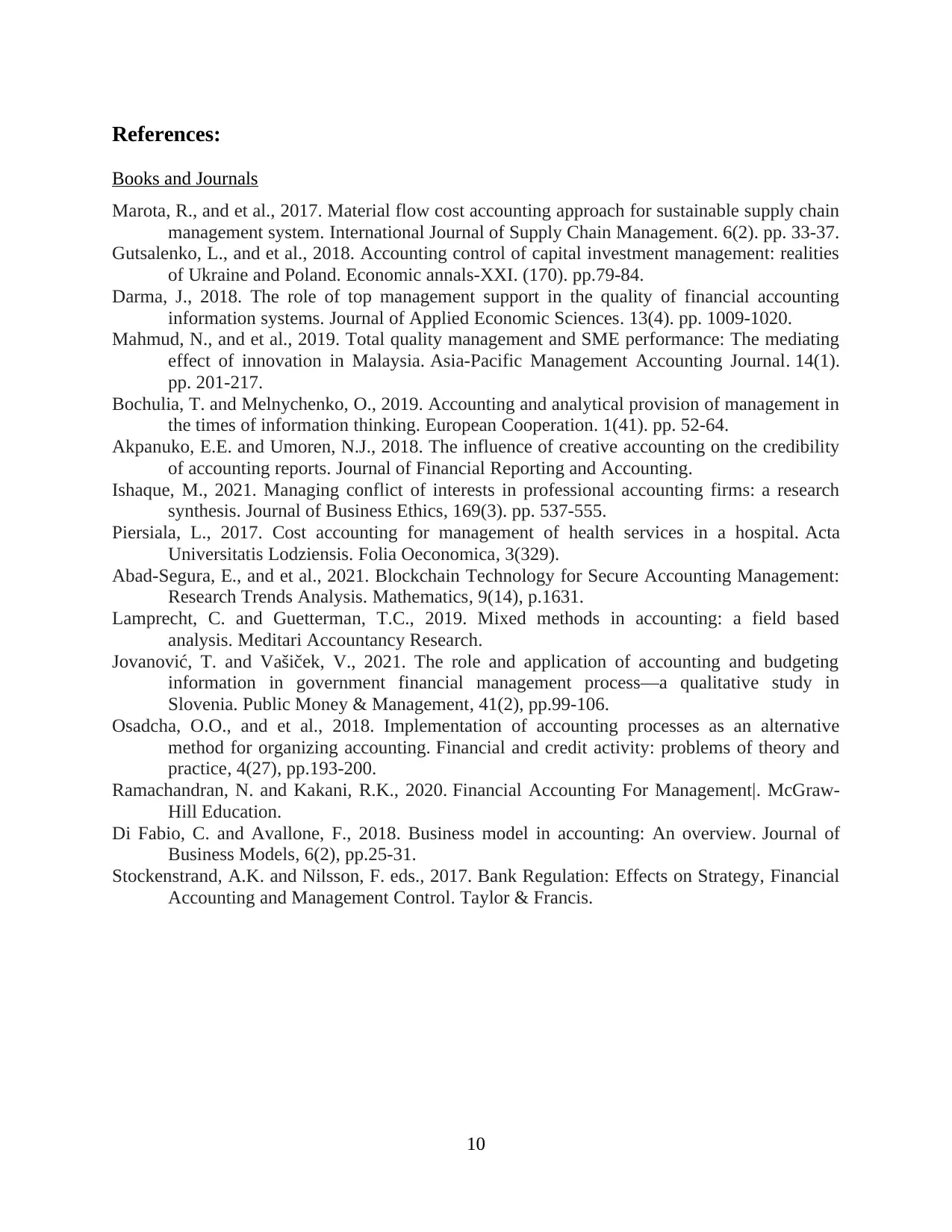
References:
Books and Journals
Marota, R., and et al., 2017. Material flow cost accounting approach for sustainable supply chain
management system. International Journal of Supply Chain Management. 6(2). pp. 33-37.
Gutsalenko, L., and et al., 2018. Accounting control of capital investment management: realities
of Ukraine and Poland. Economic annals-XXI. (170). pp.79-84.
Darma, J., 2018. The role of top management support in the quality of financial accounting
information systems. Journal of Applied Economic Sciences. 13(4). pp. 1009-1020.
Mahmud, N., and et al., 2019. Total quality management and SME performance: The mediating
effect of innovation in Malaysia. Asia-Pacific Management Accounting Journal. 14(1).
pp. 201-217.
Bochulia, T. and Melnychenko, O., 2019. Accounting and analytical provision of management in
the times of information thinking. European Cooperation. 1(41). pp. 52-64.
Akpanuko, E.E. and Umoren, N.J., 2018. The influence of creative accounting on the credibility
of accounting reports. Journal of Financial Reporting and Accounting.
Ishaque, M., 2021. Managing conflict of interests in professional accounting firms: a research
synthesis. Journal of Business Ethics, 169(3). pp. 537-555.
Piersiala, L., 2017. Cost accounting for management of health services in a hospital. Acta
Universitatis Lodziensis. Folia Oeconomica, 3(329).
Abad-Segura, E., and et al., 2021. Blockchain Technology for Secure Accounting Management:
Research Trends Analysis. Mathematics, 9(14), p.1631.
Lamprecht, C. and Guetterman, T.C., 2019. Mixed methods in accounting: a field based
analysis. Meditari Accountancy Research.
Jovanović, T. and Vašiček, V., 2021. The role and application of accounting and budgeting
information in government financial management process—a qualitative study in
Slovenia. Public Money & Management, 41(2), pp.99-106.
Osadcha, O.O., and et al., 2018. Implementation of accounting processes as an alternative
method for organizing accounting. Financial and credit activity: problems of theory and
practice, 4(27), pp.193-200.
Ramachandran, N. and Kakani, R.K., 2020. Financial Accounting For Management|. McGraw-
Hill Education.
Di Fabio, C. and Avallone, F., 2018. Business model in accounting: An overview. Journal of
Business Models, 6(2), pp.25-31.
Stockenstrand, A.K. and Nilsson, F. eds., 2017. Bank Regulation: Effects on Strategy, Financial
Accounting and Management Control. Taylor & Francis.
10
Books and Journals
Marota, R., and et al., 2017. Material flow cost accounting approach for sustainable supply chain
management system. International Journal of Supply Chain Management. 6(2). pp. 33-37.
Gutsalenko, L., and et al., 2018. Accounting control of capital investment management: realities
of Ukraine and Poland. Economic annals-XXI. (170). pp.79-84.
Darma, J., 2018. The role of top management support in the quality of financial accounting
information systems. Journal of Applied Economic Sciences. 13(4). pp. 1009-1020.
Mahmud, N., and et al., 2019. Total quality management and SME performance: The mediating
effect of innovation in Malaysia. Asia-Pacific Management Accounting Journal. 14(1).
pp. 201-217.
Bochulia, T. and Melnychenko, O., 2019. Accounting and analytical provision of management in
the times of information thinking. European Cooperation. 1(41). pp. 52-64.
Akpanuko, E.E. and Umoren, N.J., 2018. The influence of creative accounting on the credibility
of accounting reports. Journal of Financial Reporting and Accounting.
Ishaque, M., 2021. Managing conflict of interests in professional accounting firms: a research
synthesis. Journal of Business Ethics, 169(3). pp. 537-555.
Piersiala, L., 2017. Cost accounting for management of health services in a hospital. Acta
Universitatis Lodziensis. Folia Oeconomica, 3(329).
Abad-Segura, E., and et al., 2021. Blockchain Technology for Secure Accounting Management:
Research Trends Analysis. Mathematics, 9(14), p.1631.
Lamprecht, C. and Guetterman, T.C., 2019. Mixed methods in accounting: a field based
analysis. Meditari Accountancy Research.
Jovanović, T. and Vašiček, V., 2021. The role and application of accounting and budgeting
information in government financial management process—a qualitative study in
Slovenia. Public Money & Management, 41(2), pp.99-106.
Osadcha, O.O., and et al., 2018. Implementation of accounting processes as an alternative
method for organizing accounting. Financial and credit activity: problems of theory and
practice, 4(27), pp.193-200.
Ramachandran, N. and Kakani, R.K., 2020. Financial Accounting For Management|. McGraw-
Hill Education.
Di Fabio, C. and Avallone, F., 2018. Business model in accounting: An overview. Journal of
Business Models, 6(2), pp.25-31.
Stockenstrand, A.K. and Nilsson, F. eds., 2017. Bank Regulation: Effects on Strategy, Financial
Accounting and Management Control. Taylor & Francis.
10
⊘ This is a preview!⊘
Do you want full access?
Subscribe today to unlock all pages.

Trusted by 1+ million students worldwide
1 out of 12
Related Documents
Your All-in-One AI-Powered Toolkit for Academic Success.
+13062052269
info@desklib.com
Available 24*7 on WhatsApp / Email
![[object Object]](/_next/static/media/star-bottom.7253800d.svg)
Unlock your academic potential
Copyright © 2020–2025 A2Z Services. All Rights Reserved. Developed and managed by ZUCOL.


